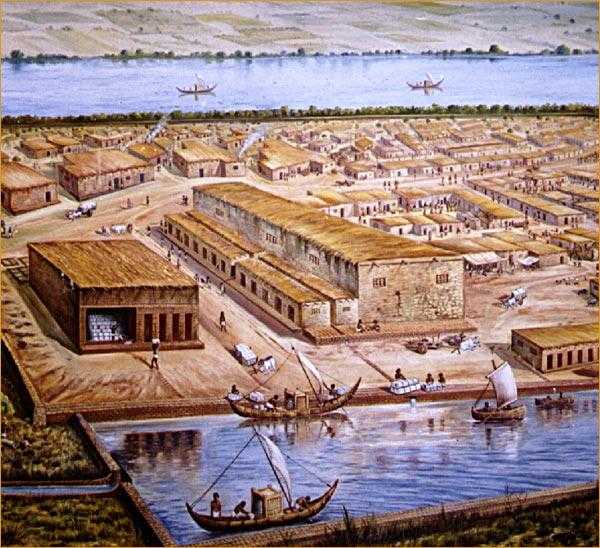Lothal: Harappan era city of Gujarat.

Lothal is an ancient city located in the modern state of Gujarat in India. It was a major city of the Harappan civilization, also known as the Indus Valley civilization, which flourished between 2500 and 1900 BCE. The city of Lothal was an important center of trade and commerce, and it is believed to have been a major hub for the production and trade of precious metals, such as copper and bronze.
In the early 20th century, the city of Lothal was discovered by archaeologists from the Archaeological Survey of India (ASI), who excavated the site between 1955 and 1960. The excavations revealed a well-planned city with a sophisticated drainage system, as well as evidence of a thriving trade in various goods. The city also had a large dockyard, which indicates that it played a key role in maritime trade.
Despite its importance as a center of trade and commerce, the city of Lothal eventually declined and was abandoned. It is not clear exactly why this happened, but it is likely that changes in trade routes and the decline of the Harappan civilization as a whole played a role.
The ASI has continued to study the site of Lothal, and in recent years they have uncovered new evidence of the city's history. For example, in 2014, they discovered a 2000-year-old wooden plank at the site, which is the oldest wooden object ever found in India. This discovery provides valuable insights into the technology and crafts of the ancient people who lived in Lothal.
In conclusion, the city of Lothal was an important center of trade and commerce in ancient India. It was a major hub for the production and trade of precious metals, and it had a sophisticated drainage system and a large dockyard. Despite its success, the city eventually declined and was abandoned, and the reasons for this are not entirely clear. The ASI continues to study the site, and recent excavations have uncovered new evidence of the city's history.
about artifacts excavated from Lothal
The city of Lothal was an important center of trade and commerce in ancient India, and it was a major hub for the production and trade of precious metals, such as copper and bronze. The Archaeological Survey of India (ASI) has conducted excavations at the site of Lothal, and these excavations have revealed a number of interesting artifacts.
One of the most significant artifacts discovered at Lothal is a large dockyard, which indicates that the city played a key role in maritime trade. The dockyard features a series of docks, slipways, and warehouses, which would have been used to load and unload goods from ships. The dockyard is considered one of the earliest and most advanced of its kind in the world.
Other artifacts discovered at Lothal include pottery, beads, seals, and tools made of copper and bronze. These artifacts provide valuable insights into the crafts and technology of the ancient people who lived in Lothal. In 2014, the ASI also discovered a 2000-year-old wooden plank at the site, which is the oldest wooden object ever found in India.
In conclusion, the excavations at Lothal have revealed a number of interesting artifacts, including a large dockyard, pottery, beads, seals, and tools made of copper and bronze. These artifacts provide valuable insights into the history and culture of the ancient city of Lothal.
How to reach Lothal.
Lothal is situated about 80 kilometers( miles) south of the city of Ahmedabad, and it is easily accessible by road.
The easiest way to reach Lothal is to first travel to Ahmedabad. Ahmedabad has its own airport, which is well-connected to major cities in India and abroad. From Ahmedabad, you can take a taxi or hire a car to reach Lothal. The journey by road takes about two hours.
Alternatively, you can also travel to Lothal by train. The nearest railway station to Lothal is Dholka, about 30 kilometres (19 miles) away. From Dholka, you can take a taxi or hire a car to Lothal.
Once you reach Lothal, you can visit the archaeological site, which is open to the public. The site is well-maintained and has a number of signboards and information boards that provide details about the history of Lothal and the artifacts discovered there. You can also visit the Lothal Museum, which has a collection of artifacts and objects found at the site.
-Ashok Chavda
how to reach Lothal from Rajkot
Lothal is located in the modern state of Gujarat in India, and it is situated about 80 kilometres (50 miles) south of the city of Ahmedabad. Rajkot, on the other hand, is located about 170 kilometres (106 miles) northwest of Ahmedabad.
If you are planning to visit Lothal from Rajkot, the easiest way to reach there is to first travel to Ahmedabad. Rajkot has its own airport, which is well-connected to major cities in India, including Ahmedabad. From Rajkot, you can take a flight to Ahmedabad and then take a taxi or hire a car to reach Lothal. The journey by road from Ahmedabad to Lothal takes about two hours.
Alternatively, you can also travel to Lothal from Rajkot by train. Rajkot has its own railway station, which is well-connected to major cities in India, including Ahmedabad. From Rajkot, you can take a train to Ahmedabad and then take a taxi or hire a car to reach Lothal. The journey by road from Ahmedabad to Lothal takes about two hours.
Once you reach Lothal, you can visit the archaeological site, which is open to the public. The site is well-maintained and has a number of signboards and information boards that provide details about the history of Lothal and the artifacts discovered there. You can also visit the Lothal Museum, which has a collection of artifacts and objects found at the site.
